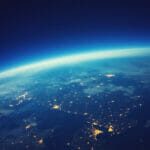During the warmer seasons of the southern hemisphere, Antarctica‘s ice begins to melt, and then freezes again during the night, causing mysterious icequakes during Antarctic nights. A group of scientists has finally managed to explain what causes them, after conducting a detailed study published in the journal The Annals of Glaciology.
A group of scientists at the University of Chicago wanted to measure the mysterious icequakes that take place during the Antarctic nights, so they placed seismometers which measure the geological activity of the ice. The seismometers were placed on the McMurdo Ice Shelf, monitoring hundreds of thousands of icequakes which were a result of melted pools of ice that were spreading and then refreezing during the Antarctic nights. The study is particularly intriguing because of its effects on glacier melting, which could help explain why and how massive ice shelves on Antarctica break off.
“In these areas we would record tens, hundreds, up to thousands of these per night,” study co-author Douglas MacAyeal, a professor of geophysical sciences and renowned glaciologist said in a statement. “It’s possible that seismometers may be a practical way for us to remotely monitor glacier melting.”
Although researchers are certain that climate change induced warming temperatures are responsible for ice melting, they still need to map and understand the fundamentals behind that occurrence, such as how, where and why.
MacAyeal and other scientists on the team wanted to explain the science behind the mysterious icequakes on floating ice shelves on Antarctica. However, they didn’t know how often the event occurs. The seismometers measured the icequakes for 60 days, during which the melt season was active on two locations near the meltwater lakes on the McMurdo ice shelf.
One location had a drier environment while the other one was slushier. There was a lot of melted ice in the lakes, which was then refreezing again during the night. Researchers found the wetter location had more seismic activity at night.
“In these ponds, there’s often a layer of ice on top of melted water below, like you see with a lake that’s only frozen on top,” MacAyeal explained. “As the temperature cools at night, the ice on the top contracts, and the water below expands as it undergoes freezing. This warps the top lid, until it finally breaks with a snap.”
This study could explain the frequency under which ice shelves are breaking off on Antarctica, given that they break off more frequently in the colder seasons of the year.
“Perhaps this is happening at longer, slower scales,” MacAyeal said. Additionally the study regarding the mysterious icequakes adds more value to the processes that occur around the ice shelves which are melting. Researchers who study global warming and its effects on the frozen continent could remotely monitor the Antarctic melting and maybe do something to prevent it.












